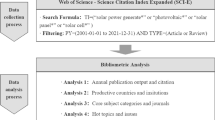Abstract
The present study explores the characteristics of hydrogen energy literature from 1965 to 2005 based on the database of Science Citation Index Expanded (SCIE) and its implication using the bibliometric techniques. The results of this work reveal that the literature on hydrogen energy grows exponentially with an annual growth rate of about 18% for the last decade. Most of document type is in the form of journal articles or meeting abstracts, constituting 90.17% of the total literature and English is the predominant language (94.66%). USA, Japan and China are the three biggest contributing countries on hydrogen energy literature publishing, 25.8%, 14.9%, 7.7%, respectively. The Chinese Academy of Sciences in China is the largest contributor publishing 308 papers. The journal literature on hydrogen energy does not confirm the typical S-shape for the Bradford-Zipf plot, but five core journals, i.e. International Journal of Hydrogen Energy, Journal of Power Source, Journal of the Electrochemical Society, Solid State Ionics, and Electrochimica Act, contributing about 41% can be identified. Journals with highly cited articles and most highly cited articles are also identified, in which the most highly cited article receives more than 1,000 citations.
Similar content being viewed by others
References
A Free Ride: Freedomcar Initiative (2003), Green Scissors 2003 FreedomCAR Initiative. http://www.greenscissors.org/transportation/freeride/htm, accessed 2007/02/02.
Ackermann, E. (2005), Bibliometrics of a controversial scientific literature: polywater research, 1962–1974. Scientometrics, 63 (2): 189–208.
Bradford, S. C. (1953), Documentation, 2nd ed., Crosby Luckwood: London, p.154.
Braun, T., Schubert, A., Zsindely, S. (1997), Nanoscience and nanotechnology on the balance. Scientometrics, 38 (2): 321–325.
Brookes, B. C. (1973), Numerical methods of bibliographic analysis. Library Trends. 22 (1): 18–43.
Hassan, E. (2005), The evolution of the knowledge structure of fuel cells. Scientometrics, 62 (2): 233–238.
ISI SCIE. http://scientific.thomson.com/product/scie, accessed 2006/05/12.
Journal Citation Reports (2005), http://www.sisnet.com/products/jcr.
Meyer, M., Persson, O. (1998), Nanotechnology-interdisciplinarity, patterns of collaboration and differences in application. Scientometrics, 42 (2): 195–205.
Patra, S. K., Bhattacharya, P., Verma, N. (2006), Bibliometric study of literature on bibliometrics. DESIDOC Bulletin of Information Technology, 26 (1): 27–32.
Schummer, J. (2004), Multidisciplinarity, interdisciplinarity, and patterns of research collaboration in nano science and nano technology. Scientometrics, 59 (3): 425–465.
Thomas, S., Zalbowitz, M. (2003), Fuel Cells-Green Power, Los Alamos National Laboratory, Department of Energy, United States of America, 33p.
Tsay, M. Y., Yang, Y. H. (2005), Bibliometric analysis of the literature of randomized controlled trials. Journal of the Medical Library Association, 93 (4): 450–458.
Ulrich’s Periodicals Directory (2005), http://www.bowker.com/catalog/000012.htm.
U.S. Department Of Energy (2006), Energy Efficiency and Renewable Energy, “Hydrogen, Fuel Cells and Infrastructure Technologies Program”. http://www1.eere.energy.gov/hydrogenandfuelcells/presidents_initiative.html, accessed 2006/05/31.
The White House President George W. Bush. (2003), Fact Sheet: Hydrogen Fuel: a Clean and Secure Energy Future. http://www.whitehouse.gov/news/releases/2003/02/20030206-2.html, accessed 2007/02/02.
Author information
Authors and Affiliations
Corresponding author
Rights and permissions
About this article
Cite this article
Tsay, MY. A bibliometric analysis of hydrogen energy literature, 1965–2005. Scientometrics 75, 421–438 (2008). https://doi.org/10.1007/s11192-007-1785-x
Received:
Published:
Issue Date:
DOI: https://doi.org/10.1007/s11192-007-1785-x




